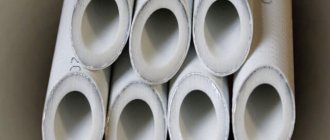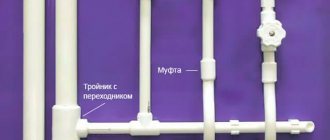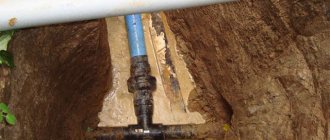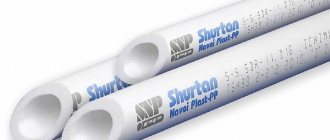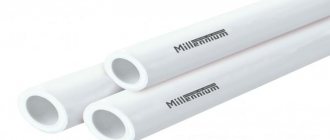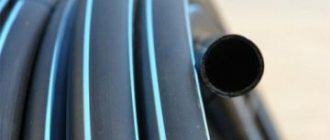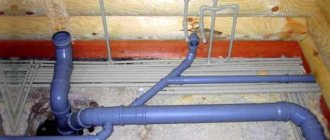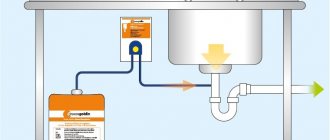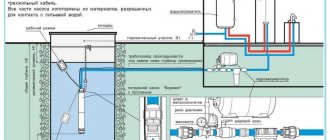Necessary tools and materials for soldering
To work at home, you will need to prepare in advance all the necessary tools and materials:
- electric soldering iron;
- nozzles and stands for a soldering iron of the appropriate size;
- a file or sharp knife for removing burrs;
- measuring ruler or tape measure;
- marker;
- pipe cutting scissors;
- shaver - a device for removing the reinforcing layer;
- special tool for chamfering;
- solder for soldering;
- fluxes and fittings;
- alcohol composition for degreasing.
Solder for soldering
Solder comes in the form of wire, foil, rod, etc. It is necessary to obtain a stronger weld on copper structures. It is made on the basis of tin, silver, zinc, lead, antimony or copper.
Depending on the melting point it is divided into:
- fusible;
- medium fusible;
- high fusible solder.
Fluxes and fittings
Fluxes are used in soldering to protect the metal surfaces being joined from oxidation. They are available in the form of a liquid, a dry mixture or a paste and differ in chemical composition, properties and purpose. For example, boric acid, zinc chloride, and hydrochloric acid are used to clean the surface of rolled copper and increase the fluidity of solder.
A protective film can be created using rosin, wax, and various resins.
Fittings are small-sized products that are placed on the ends of pipes that are connected by soldering. These include couplings, tees, crosses, contours, plugs, corners, etc. They must be made of the same material as the pipes themselves. And of course, it’s no secret that you can buy fittings at any plumbing store.
Cutting scissors
This type of tool has other names - pipe cutter, pipe shears or pipe cutter. It is designed for fast cutting of plastic products, providing a burr-free cutting edge, which simplifies preparation for the welding process.
There are 4 types of pipe shears, differing in design and price:
- precision pipe cutter with a ratchet mechanism. The device is used for cutting pipes with a diameter of no more than 75 mm;
- roller shears;
- automatic pipe cutter in the shape of a pistol;
- pipe cutter - guillotine.
Connection of aluminum reinforced pipes
It is required to follow the rules when welding polypropylene pipes with reinforcement. The reinforced layer is made of aluminum or fiberglass.
They are used when installing systems that move water at high temperatures, because under the influence of heated liquid, linear expansion of the material and bending of the pipeline occurs.
When performing soldering, the aluminum protective material must be removed. In addition, this layer affects the quality of the connection, and the welding time depends on the heating period of the polypropylene parts.
Reinforced pipelines have a larger diameter. Therefore, it will not be possible to use standard nozzles on a heating tool without first preparing the products.
This is done by stripping parts. It is not carried out for glass fiber reinforced products. They are connected in the same way as unreinforced pipelines.
Stripping is performed using different methods, because there are many technologies for reinforcing polypropylene products. Processing is most often used when using a shaver. It is a metal device in the form of a sleeve with blades.
Shaver
The tool is placed on the end of the tubular product and rotated, allowing the aluminum protective layer to be removed. The process continues until only one piece of plastic remains.
PP pipes can be designed when the reinforced layer is in the middle of the wall thickness. In this case, a trimmer is used. This instrument is very similar to a shaver. Different arrangement and design of knives.
The tool allows you to make the ends smooth and remove 2 mm of the reinforced layer located in the middle of the pipe wall thickness. Thanks to this processing, you will be able to perform high-quality soldering.
Tips for choosing and using a pipe soldering iron
When choosing a pipe soldering iron, you should take into account its technical parameters:
- power. Powerful devices are needed for welding large-diameter pipes; for domestic systems, in which the diameter of the products does not exceed 50 mm, you can purchase a device with a power of 0.6 - 0.8 kW;
- quality of coating of nozzles and technology of their use. The products to be welded can be easily removed from Teflon-coated nozzles, so it is advisable to choose a soldering iron equipped with just such nozzles. In addition, you should pay attention to the possibility of heating not only one, but two or three nozzles at the same time. This will significantly speed up the work;
- type of temperature controller. The soldering iron can be equipped with an electronic, capillary or bimetallic thermostat. It is better to choose a model with an electronic temperature controller, since the other two have too large a discrepancy between the set and actual heating temperature of the products.
Brief instructions
First, fittings and pipes that require processing are prepared for welding. The foil layer must be removed if we are talking about reinforced products. It is necessary to degrease all parts that will need to be soldered later.
Video 3. Soldering a PVC pipeline on the wall with a soldering iron
Then a mark is applied to the pipe, which is placed at the melting depth plus 2 mm. We take a soldering iron and install suitable sized nozzles on it.
On one side, a connecting element is mounted on the welder’s heater, and the pipe itself is fixed on the other end. The coupling is used somewhat differently.
The main thing is to observe when welding the time required to process certain parts. Rearranging, fixing and heating with your own hands requires compliance with certain time intervals.
Parts will not be deformed only if each action is performed smoothly. On the welding machine you need to set the operating melting temperature. Usually it is equal to 260 degrees. Otherwise it is impossible to solder.
You need to wait some time after the process is completed for the structure to cool down. Observe the same requirements when using a coupling.
Video 4. Do-it-yourself soldering of PVC pipeline
The essence of the process and soldering methods
Soldering is used for hermetically connecting pipeline sections to each other, installing shut-off valves, control, measuring and safety devices.
Three soldering technologies are used to connect the ends of pipes and pipe fittings:
- diffusion method. Welding is carried out by heating and squeezing the connecting elements without melting the base material of the parts and the use of additional substances;
- soldering using electrical fittings. For connection, special fittings with a heating element are used. The soldering process occurs due to partial melting of the internal part of the electrical fitting under the influence of electric current;
- cold way. The elements of the heat pipe are connected using additional material - solder.
We purchase the necessary equipment
Video 1. DIY PVC soldering process and what tools are needed
This kind of work can be done almost alone, without special equipment. But the procedure requires minimal equipment. This:
- A soldering iron that comes with several attachments. The main thing is that there is a correspondence between the soldering iron nozzles and the diameter of the pipeline.
- Scissors for cutting. The main thing is that the tool is sharpened, then the parts will not be deformed.
Every action and decision must be verified. Soldering technology gives up to 15 years of uninterrupted operation of the system if done correctly.
Therefore, it makes sense to thoroughly understand how to properly solder PVC pipes.
Video 2. Soldering a PVC pipeline with a Chinese soldering iron
Step-by-step instructions for soldering plastic pipes
Pipeline soldering consists of three main phases - heating, joining, fixing and cooling of elements, the implementation of which requires certain preparation, compliance with temperature conditions and safety rules.
Security measures
During the soldering process, you need to follow basic safety precautions for working with power tools:
- the soldering iron must be protected from precipitation, dirt and splashes;
- Before connecting the device to the network, you must make sure that it is in working order and that the power cord and plug are intact;
- During work, you should ventilate the room and use thermal gloves;
- Do not touch exposed skin to heated surfaces.
Preparation of elements and parts
At this stage you need to do:
- cutting products into pieces of the required length;
- cleaning the cuts from burrs and thoroughly polishing them;
- degreasing the sections with an alcohol solution;
- drawing a notch by which it will be possible to control the depth of insertion of pipes into the apparatus;
Preparing the soldering iron
The device must be connected to the network in advance, the thermostat must be set to the desired position and the product must be heated to operating temperatures, depending on the type of plastic.
Typically, the heating time of the soldering iron is 30 minutes until the light goes out. The device will be ready for operation 10 minutes after reaching the set temperature.
When preparing the apparatus, it is also advisable to additionally control the temperature of the fittings and sleeves with a surface electric thermometer.
At what temperature should plastic pipes be soldered?
For soldering polyethylene products, the temperature regulator on the device is set to 220ºС, for polypropylene products - to 260ºС. If there is no regulator, you can adhere to the heating parameters of the parts from Table 1.
Table 1.
| Parameter name | Pipe diameter, mm | |||||
| 20 | 25 | 32 | 40 | 50 | 63 | |
| Product heating time, sec | 6 | 7 | 8 | 12 | 18 | 24 |
| Product heating time, sec | 4 | 4 | 6 | 6 | 6 | 8 |
| Cooling time, min | 2 | 2 | 4 | 4 | 4 | 6 |
Docking rules
When assembling joints, it is necessary to ensure that the edges are aligned so that the surfaces of both products coincide and the axis of the pipeline does not shift. The gap between the edges should be uniform over the entire diameter with a size of 2 - 3 mm.
Pipe connection
The heated parts are removed from the soldering iron nozzles and connected to each other, lightly pressing with their ends. The polymer will harden in 2-3 minutes.
Cleaning and cooling connections
The connection point should be in a stationary position until the plastic cools to a temperature of 38 - 42 degrees. To do this, the connected parts are fixed in a clamp or clip until cooling.
Cleaning of the deposits is carried out with a sharp knife after the joint area has completely cooled.
Checking the connection quality
At the end of welding, all joints are subject to visual inspection. A high-quality weld should have a smooth surface, without traces of porosity, cracks, folds and excessive shine that occur when overheated. The bead in the weld area must be continuous and uniform along the entire circumference of the joint and rise above the outer surface by no more than 2 mm - for products with a wall thickness of up to 10 mm.
The maximum bead height for pipes with larger wall thicknesses is 4 mm.
Preparation for installation of water supply from polypropylene pipes
It is safe to say that high-quality preparation for wiring assembly largely determines its performance and durability.
Watch the video
In addition, one of the main tasks of these activities is to calculate the real need for water supply elements.
Selecting a connection diagram
Currently, two main schemes for installing pipework are common:
Tee - with it, each water consumer is connected to a central pipe connected to a riser. Tees are used for this.
The disadvantage of this scheme is the fact that when several taps are opened simultaneously, the pressure in the supply pipe decreases sharply and the flow of water in each of them decreases. Parsing points remote from the riser are especially affected.
The second negative point is that if the need for routine repairs arises, you have to turn off the entire water supply circuit for this time.
Tee circuits are used in apartments or small private houses. The advantages include ease of installation and relatively low consumption of materials.
Collector wiring diagram . This method of forming a water supply network is that from the riser the supply pipe is led to the topographic center of the water supply system and ends with the installation of a comb.
The comb is a short pipe with threaded elbows installed on it for a ball valve. Thus, a distribution node is formed, from which distribution to points of consumption is carried out.
As a result, it is possible to shut off any water consumption point separately. The rest of the system continues to function as usual with the same water flow.
Operating temperature conditions
Manufacturers of products for water supply systems declare a maximum coolant temperature of 95 degrees. However, the physical properties of the material differ somewhat from this indicator.
Softening of polypropylene begins to appear at a temperature of about 140 degrees, melting occurs at 175. Taking these parameters into account, we can conclude that this material is suitable for any heating water pipes, with the exception of steam.
The operating temperature in the steam lines is exactly 175 degrees.
It would seem, what could be better? But the peculiarity of the material is that at a temperature of 135 degrees it begins to soften. The wiring begins to sag, thin out, and eventually a rupture occurs.
Manufacturers of polypropylene pipes officially declare a significantly lower permissible temperature, wanting to insure their products and make them more durable.
It should be noted that in a properly equipped home with sufficient thermal protection of the walls, this operating temperature is quite sufficient.
It should be noted that in heating systems it is advisable to use reinforced polypropylene pipes, which have a number of advantages:
- Stability of linear expansion of water supply elements under the influence of thermal and mechanical loads. They can withstand pressures of up to 10 atmospheres without noticeable changes.
- The service life of a reinforced pipeline, constantly under pressure at elevated temperatures, is several times longer than that of non-reinforced products.
- The melting point in both products is the same, but under equal conditions, a pipe without reinforcement is destroyed, but a reinforced one is not.
Common mistakes
Soldering plastic pipes does not require special skills, but if you do not adhere to established norms and rules, you can still ruin the connection. Typical mistakes of novice masters are:
- using dirty attachments. If drops of molten polymer remain on the nozzles, then during the next welding they can wedge between the edges of the products and sharply weaken the connecting seam;
- residual water and dirt on the outer surface. They will prevent close contact of the surfaces of parts over the entire area;
- applying excessive force when combining parts. Part of the melt under excess pressure can be squeezed into the pipe and reduce its permeability;
- an attempt to clean up the sagging of molten plastic before the joint has completely cooled, which inevitably leads to deformation of the pipe;
- insufficient heating or overheating of the joint.
Features of the welding process
There are some nuances, observance and consideration of which will help achieve maximum results, regardless of how you solder.
- It is necessary to thoroughly clean all connection points from dirt and dust.
- The joint will need to be degreased. Without this it is impossible to solder.
- The pipes do not need to be inserted into the structure all the way. Fitting joints require careful preparation. The coupling is no exception.
- Chamfers are always removed. This is necessary so that the pipe fits tightly into the fitting without additional effort.
The soldering itself begins when the preliminary stages of preparation are completed. Adhesion can be divided into four stages. It doesn't matter whether a coupling is used or not.
- Slicing.
- Warming up.
- Compound.
- Cooling.
For slicing, special types of scissors are used, designed specifically for this purpose. If you use the right tool, the pipes will not become deformed in the future.
The apparatus used for soldering must also be oriented to the desired diameter.
Be sure to use thermal gloves to protect yourself. Welding PVC pipes with your own hands is not such a difficult process.
Expert advice
To ensure maximum reliability of pipeline connections, experts advise adhering to the following requirements:
- it is correct to start welding work 10 minutes from the moment the soldering iron warms up;
- perform welding or soldering operations only at above-zero ambient temperatures;
- sections of pipes connected by welding must be allowed to cool, preventing them from moving relative to each other or twisting;
- For wall thicknesses greater than 6 mm, butt welding of products is performed using a double seam. With a smaller wall thickness, the joint can be sealed with one seam;
- all structural elements fixed by soldering must be from the same manufacturer, since they may differ in the composition of the ingredients in the raw materials, which will negatively affect the quality of the weld.
Soldering in hard-to-reach places and corners
When soldering pipes located in hard-to-reach places, for example, close to the surface of walls or ceilings, a special technique is used, which consists of sequential heating of the direct and counter sections of the connection with a soldering apparatus. It is necessary to warm up the flange of the straight section for a longer period of time so that it does not have time to cool down while the counter part of the workpiece is in operation.
A smooth line at corner joints of pipes can be achieved by using special corner adapters and fittings. In this case, it is important to very accurately mark in advance on the supply pipes the depth of their entry into the body of the corner piece.
Connecting plastic pipes without soldering
Plastic pipes do not have to be welded; they can be joined using a special adhesive. It is applied to the entire pre-degreased surface of the pipe section that will be inserted into the socket. In the bell, the inner surface is also degreased and covered with glue, but only 2/3. For better adhesion, the surfaces of the pipes under the adhesive joint are treated with sandpaper before degreasing.
The prepared part of the pipe is inserted into the socket until it stops and rotated 90 degrees. In this position, the parts to be glued should be held for 1 - 1.5 minutes until the glue sets.
The adhesive will dry completely within a few hours.
Plastic sewer pipes leading to the Tank septic tank can be connected using a compression fitting. With this method, the process of connecting pipes consists of the following steps:
- cleaning the top layer of the pipe from contaminants;
- chamfering at the end;
- loosening the union nut on the fitting and installing the end of the pipe into it;
- tightening the nut in the reverse position, at this moment the pipe is clamped (compressed) by the ferrule ring.
Fittings are fixed manually or using an open-end wrench. The applied force should not be excessive, otherwise the pipes may burst.
The socket method involves the use of a highly elastic sealing ring. The tightness of the connection is ensured by compression of the gasket between the walls of the socket and the smooth end of the pipe.
Welding large diameter plastic pipes
To connect pipes with a diameter of more than 50 mm and a wall thickness of 4 mm, butt soldering technology is used, which consists of simultaneous welding of the ends of 2 segments along the entire plane. The most difficult thing in this welding method is to correctly align the joints and ensure the required length of the gap between the parts.
Therefore, in the process of butt welding of large diameter pipes, guides or a pipe centralizer are used. It will provide high-quality and reliable fixation of sections for welding.
The work itself is carried out in the following order:
- pipe preparation and edge cleaning;
- securing elements in a pipe centralizer;
- welding of joints of products.
Impact of errors on welding quality
Unhurried, carefully considered actions are a guarantee against mistakes that can ruin all the work. You should take into account all the little details of soldering technology and not deviate one step from them.
Common mistakes that result in defective components of the installed propylene water supply network:
- The surface of the pipe has not been cleaned of grease film.
- The cutting angle of the mating parts differs from the value of 90º.
- Loose fit of the end of the pipe into the fitting.
- Insufficient or excessive heating of the parts being soldered.
- Incomplete removal of the reinforced layer from the pipe.
- Correcting the position of parts after the polymer has set.
Sometimes on high-quality materials, excessive heating does not produce visible external defects. However, internal deformation is noted when molten polypropylene closes the internal passage of the pipe. In the future, such a unit loses its functionality - it quickly becomes clogged and blocks the flow of water.
An example of a soldering defect resulting from erroneous actions. The master overheated the plastic pipe, which, in turn, became deformed from the inside
If the cut angle of the end parts differs from 90º, at the moment of joining the parts, the ends of the pipes lie in a beveled plane. A misalignment of parts occurs, which becomes noticeable when a line several meters long has already been installed.
Often for this reason it is necessary to redo the entire assembly again. Especially if pipes are laid in grooves.
Poor degreasing of joint surfaces contributes to the formation of “rejection islands.” At such points, polyfusion welding does not occur at all or occurs partially.
Pipes with such a defect work for some time, but a burst can occur at any moment. Also common are errors associated with loose fitting of the pipe inside the fitting.
A common mistake when soldering polypropylene pipes is that the end of the pipe does not fit tightly into the socket. The pipe must extend to the border of the rim or marking line
A similar result is shown by connections made with incomplete cleaning of the reinforcing layer. As a rule, a reinforced pipe is installed on high pressure lines. Residual aluminum foil creates a non-contact zone in the soldering area. It is at this point that leaks often occur.
The biggest mistake is an attempt to correct the soldered elements by scrolling around an axis relative to each other. Such actions sharply reduce the effect of polyfusion welding.
However, adhesions are formed at individual points, and a so-called “tack” is obtained. With a small tensile force, the “tack” holds the connection. However, as soon as you put the connection under pressure, the solder will immediately fall apart.
Additional information on welding polypropylene pipes is presented in this article.
Some tips from the professionals
Recommendations from experts will help you correctly connect plastic elements:
- In order for the soldering of plastic elements of a sewer or water supply network to be carried out correctly, before starting welding, you should keep the soldering iron heated to the required temperature for at least 5 minutes.
- After soldering the elements, they must be allowed to cool, without moving them or twisting them, since then the seam will be of poor quality. If you do not follow this advice, you will need to cut the joint, remove the damaged fitting, and start the whole process again.
- When pipe products are reinforced with aluminum, the top two layers of the product should be removed and only then, according to the technology described above, the connection can be made.
How to choose glue?
When choosing how to glue a sewer pipe, you need to pay attention to the following factors:
- gluing material;
- setting time;
- technology of use;
- temperature conditions;
- time and storage conditions after opening the package.
All the necessary information is described in detail in the instructions, which should be read carefully.
There are 2 main groups of adhesive materials for gluing plastic pipes:
- One-component compositions. Such products are sold ready-made and do not require pre-mixing of the components. Adhesives are packaged in glass, plastic or metal containers and are used to join different types of plastic. They consist of dissolving, softening and joint-forming chemically active substances. But they do not have additives or additives that can change the duration of the chemical reaction and increase the strength of the joint. A typical example of such materials is sealant for polyvinyl chloride and polypropylene (Moment).
- Two-component compositions. They are produced in the form of 2 separate components, which are in different packages. Immediately before use they are mixed. Chemically more complex compounds, because they contain elements that improve adhesion and reduce the evaporation time of solvent components. The addition of additives helps accelerate the formation of stable polymer chains, resulting in stronger atomic-level bonds. Higher joint quality is ensured.
A convenient and effective way to quickly glue all types of pipelines is to use a special sealing tape.
Method of socket welding of large diameter PP pipes
For welding work using socket technology, the same tools are used as for butt welding, with the exception of equipment designed for even cutting of the end part of pipes. And the soldering iron has a slightly different design. The main element of the soldering apparatus is the heating head, on which mandrels are fixed, designed to heat the pipes from the outside, and couplings, with the help of which a temperature effect is provided on the internal surfaces of the fittings. During heating, the pipe is inserted into the mandrel, and the fitting is pressed onto the coupling. After removing the soldering apparatus, the heated parts are connected. If the elements cannot be heated at the same time, then the fittings are heated first, and then the pipes.
The sequence of operations is also identical to the previous method, but in this case precise alignment of the ends is not required, so the need to perform this operation automatically disappears.
The socket method is suitable for welding pipes up to D=125 mm inclusive. Its use does not require special precision when cutting pipes into blanks. And the additional use of fitting products is not a disadvantage of this method, since fittings not only act as connecting elements, but also allow you to change the direction of the pipeline.
Thus, the use of polypropylene pipes significantly reduces material and time costs during installation, ensures simplicity and convenience of installation work, and the welding method used allows us to obtain a strong and reliable weld. The main thing is to follow the technology and withstand all operating conditions.
Source
What is needed for the job?
First of all, these are the pipes and fittings themselves. You can read in detail about the diameter and dimensions of the sewer pipe in another article; we will only remind you of the obvious fact that you should choose pipes of the same brand. Otherwise, difficulties may arise even when connecting pipes of the same size but from different manufacturers.
In addition, you will need: •A hacksaw or other cutting tool with a fine tooth. •File. •Sanding paper. •Solvent. •Glue. •Brush.
As for glue, there are both specialized brands on sale, intended exclusively for PVC pipes, and universal ones, used for joining various materials that contain PVC or its derivatives. The best option is specialized adhesives, many of which guarantee a reliable joint for 10 years or more.
Differences between soldering plastic and metal-plastic
Many people are interested in how to properly weld metal-plastic products. The interesting thing is that such a concept does not exist in the work of professionals. Aluminum pipes are welded. In this case, the butt or overlap technique is used. Fittings are used for connection.
Types of fittings:
- Compression;
- Press fittings.
Press fittings are more durable. The pipes are connected by pressing using a special tool. To tighten compression connections, use a simple wrench. But such fittings do not include welding.
Polypropylene pipes reinforced with aluminum are available on the market. They are used in heating and hot water supply systems. These are the devices that require welding.
To avoid mistakes, it is better to watch a training video before soldering.
Welding is not used for metal-plastic products. But reinforced products are connected in exactly this way. Among plastic pipes, PVC options are popular. Their expansion coefficient is small. The characteristics of the products allow them to be used only for sewerage installations. But large diameter pipes can be used for central water supply. Installation can be carried out by welding or gluing.
